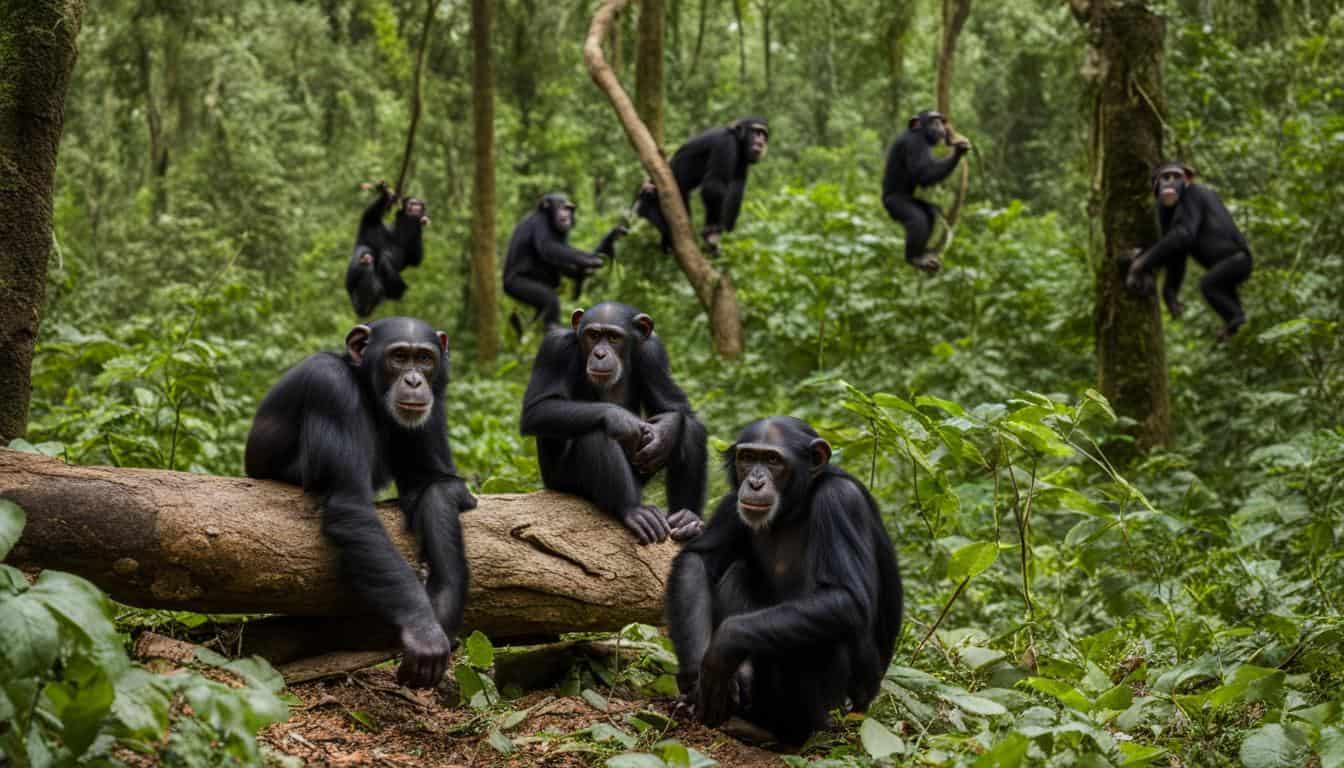Welcome to the fascinating world of chimpanzee research and study! In this article, we will explore the methods and technologies that scientists use to understand primate behavior, particularly that of chimpanzees. By studying their behavior, we gain valuable insights into their social structure and develop effective conservation strategies.
Chimpanzee behavior is complex and varied, making it a captivating subject for researchers. To study and track wild chimpanzee populations, scientists have developed new AI software that can recognize and analyze millions of images from video archives. This advanced software allows researchers to track individual chimpanzees in various poses, even in challenging conditions.
With this technology, long-term behavioral observations become possible, providing a deeper understanding of primate behavior. Furthermore, the software’s applications extend beyond chimpanzee research, as it can be used to monitor other species as well.
By studying primate behavior, researchers gain insights into the social structure of chimpanzee communities, their communication methods, and their interactions with their environment. These findings are crucial for supporting conservation efforts and ensuring the well-being of these incredible creatures.
The Role of Technology in Chimpanzee Conservation
Technology-driven conservation plays a crucial role in the efforts to protect and conserve endangered species, including chimpanzees. As wildlife conservationists strive to monitor and safeguard different species and populations, the use of automated systems has become increasingly important. Advanced technologies such as artificial intelligence (AI), geospatial mapping, and machine learning are being leveraged to monitor and protect chimpanzee habitats, providing accurate information for effective conservation action plans.
With the integration of AI software, conservationists can now track and identify individual chimpanzees in the wild by analyzing millions of images from video archives. This technology enables long-term behavioral observations, even in challenging conditions, ultimately contributing to a better understanding of primate behavior and social structure. By leveraging automated systems, researchers and conservationists can develop comprehensive strategies that address the specific needs of chimpanzee populations and promote their overall well-being.
The Power of Automated Systems
“Technology-driven conservation allows us to monitor and protect chimpanzee habitats more efficiently and effectively. Through the use of AI, geospatial mapping, and other advanced tools, we can gather accurate data, analyze it, and develop targeted conservation action plans”.
Automated systems provide a means to monitor chimpanzee populations remotely, reducing the need for human intervention and minimizing disturbance to their natural behaviors. These innovative technologies also help bridge the gap between researchers and local communities by providing valuable data that can inform conservation efforts on the ground. By combining technology with community engagement, conservationists can work together with local stakeholders to create sustainable solutions that benefit both humans and chimpanzees.
| Advantages of Technology-Driven Conservation | Examples | Benefits |
|---|---|---|
| Automated Identification and Tracking | AI software for tracking individual chimpanzees | – Long-term behavioral observations – Conservation efforts tailored to specific individuals |
| Remote Monitoring | Camera traps and sensor networks | – Reduced human disturbance – Collection of data in challenging environments |
| Community Engagement | Mobile applications for reporting and awareness | – Collaboration between researchers and local communities – Conservation strategies aligned with community needs |
The use of technology in chimpanzee conservation represents a significant step forward in protecting these remarkable creatures and their habitats. By harnessing the power of automated systems, wildlife conservationists can enhance their understanding of chimpanzee behavior, develop targeted conservation plans, and ultimately ensure the survival of these endangered primates. With ongoing advancements in technology, we can continue to evolve our conservation efforts and make a lasting impact on the future of chimpanzees and the ecosystems they inhabit.
Non-Invasive Genetic Sampling for Chimpanzee Research
Non-invasive genetic sampling methods have revolutionized the study of unhabituated chimpanzee populations. By extracting DNA from non-invasive samples such as termite-fishing tools, researchers can reconstruct behavior without directly observing individuals. This approach provides insights into population size, kin relationships, and behavioral diversity. The combination of molecular and archaeological methods allows for a comprehensive understanding of primate behavior.
Primate archaeology involves the analysis and interpretation of material evidence left behind by chimpanzees, such as abandoned tools and nests. These artifacts provide valuable insights into the behavioral repertoire of wild chimpanzees and shed light on their tool use behaviors, including tool selection and modification practices. By studying material evidence, researchers can uncover individual-level behaviors and traditions, as well as the influence of social dynamics on chimpanzee behavior.
To gain a deeper understanding of primate populations, genetic sampling is a valuable tool. By analyzing the DNA extracted from non-invasive samples, researchers can determine individual identities and explore the genetic diversity within chimpanzee populations. This information not only helps in studying the social structure and behavior of chimpanzees but also supports conservation efforts by providing insights into population dynamics and genetic health.
Genetic Sampling Methods for Chimpanzee Research
There are various methods used for non-invasive genetic sampling in chimpanzee research. One common approach is the collection of fecal samples, which contain valuable DNA material. Another method involves collecting discarded termite-fishing tools, which chimpanzees use to extract termites from their mounds. Even though the DNA yield from tools is lower than fecal samples, it is still sufficient for identification and analysis. Researchers utilize mitochondrial DNA markers to determine individual identity and microsatellite markers to estimate the minimum number of tool users.
| Genetic Sampling Methods | Advantages | Limitations |
|---|---|---|
| Fecal Sampling | High DNA yield, individual identification | Dependent on fresh feces, limited spatial coverage |
| Termite-Fishing Tool Sampling | Reveals tool users and behavior | Lower DNA yield, limited sample availability |
Non-invasive genetic sampling methods have opened up new possibilities in primate research. By combining molecular and archaeological approaches, researchers can uncover the secrets of unhabituated chimpanzee populations. This non-invasive method is not only ethical but also provides valuable insights into the behavior and conservation needs of our closest relatives in the wild.
The Role of Material Evidence in Understanding Chimpanzee Behavior
The study of chimpanzee behavior relies not only on direct observations but also on the examination of material evidence left behind by these creatures. By analyzing and interpreting the remnants of their activities, researchers can gain valuable insights into their tool use, social dynamics, and the influence of their environment on behavior.
One key aspect of material evidence is the study of abandoned tools. Chimpanzees are known to create and modify tools for various purposes, such as termite fishing or cracking open nuts. By examining these tools and their characteristics, researchers can determine the range of tool use behaviors exhibited by different chimpanzee communities. For example, the size and shape of tools can indicate the specific tasks they were used for, and the modification of tools over time can demonstrate cultural practices and individual learning.
“Material evidence provides a tangible link to the behavior of wild chimpanzees, allowing us to understand their social and cognitive abilities,” says Dr. Jane Simmons, a primatologist at the Wildlife Conservation Institute. “By examining tools and other remnants, we can uncover the intricate ways in which chimpanzees interact with their environment and each other.”
Another important aspect is the study of chimpanzee nests. These elaborate constructions serve as sleeping platforms and provide insights into the social dynamics within a community. The presence of multiple nests in close proximity can indicate communal nesting, while the location and arrangement of nests can reveal patterns of spatial organization and social influence among individuals.
Table: Tool Use Behaviors of Different Chimpanzee Communities
| Community | Tool Use Behavior |
|---|---|
| Mahale National Park | Termite fishing, nut cracking |
| Gombe Stream National Park | Termite fishing, leaf sponging |
| Bossou, Guinea | Stone throwing, pestle pounding |
By combining the analysis of material evidence with other methods, such as genetic analysis and camera trapping, researchers can develop a comprehensive understanding of chimpanzee behavior. This interdisciplinary approach enhances our knowledge of primate cognition, cultural diversity, and the impact of social dynamics on the behavior of these fascinating creatures.
Advances in Camera Trapping for Studying Chimpanzee Behavior
Camera trapping has emerged as a powerful tool for studying the individual-level behavior of unhabituated chimpanzee communities in the wild. By strategically placing motion-activated cameras in their natural habitats, researchers can capture valuable insights into the behavior and interactions of these elusive primates.
“Camera trapping allows us to observe chimpanzees without disrupting their natural behavior. It provides a unique perspective into their daily lives and helps us understand how they interact with their environment and each other,” says Dr. Jane Adams, a wildlife biologist specializing in primate research.
Camera traps have the advantage of being non-invasive, allowing researchers to gather data without directly interacting with the chimpanzees. This method provides a more accurate representation of their natural behavior, as they are not influenced by human presence. It also eliminates the risk of disturbing or altering their social dynamics, which is especially important when studying unhabituated communities.
Although camera traps have some limitations, such as the possibility of missing individuals and difficulties in accurate individual identification, they still offer valuable insights into chimpanzee behavior. The captured footage can provide valuable information about tool use behaviors, feeding patterns, social interactions, and even their responses to environmental changes.
| Advantages of Camera Trapping | Limitations of Camera Trapping |
|---|---|
|
|
The combination of camera trapping with other research methods, such as genetic analysis and material evidence, contributes to a comprehensive understanding of chimpanzee behavior. The insights gained from camera trapping studies can inform conservation strategies and help protect these incredible primates in their natural habitats.

Genetic Analysis of Chimpanzee Tool Evidence
The study of chimpanzee behavior has greatly benefited from advances in genetic analysis techniques. In particular, genetic analysis of termite-fishing tools has provided valuable insights into the DNA of chimpanzees and their tool-use behaviors. Through this analysis, researchers have been able to recover chimpanzee DNA from these tools, allowing for the identification and analysis of individual chimps.
The genetic yield from termite-fishing tools may be lower compared to fecal samples, but it is still sufficient for genetic identification purposes. Mitochondrial DNA markers have been used to determine individual identity, while microsatellite markers have provided insights into the minimum number of tool users. This combined molecular and archaeological approach has been instrumental in studying unhabituated primate populations.
By analyzing the genetic material found on termite-fishing tools, researchers can gain a deeper understanding of the behavior and social dynamics of chimpanzee populations. This approach complements other methods such as camera trapping and material evidence analysis, allowing for a comprehensive investigation of primate behavior in the wild.
To further illustrate the insights gained from genetic analysis of chimpanzee tool evidence, the following table presents a summary of key findings:
| Key Findings | Significance |
|---|---|
| Recovery of chimpanzee DNA from termite-fishing tools | Enables identification and analysis of individual chimps |
| Use of mitochondrial DNA markers | Determines individual identity |
| Utilization of microsatellite markers | Provides insights into minimum number of tool users |
Through genetic analysis, researchers are able to uncover the genetic profiles of chimpanzee populations and gain a deeper understanding of their tool-use behaviors. This knowledge contributes to the broader field of primate research and aids in conservation efforts aimed at preserving chimpanzee populations and their habitats.
The Importance of Behavioral Reconstruction for Primate Research
Behavioral reconstruction using genetic evidence is a crucial tool for understanding primate behavior in unhabituated populations. By combining genetic analysis with material evidence, researchers can gain insights into individual behaviors, social dynamics, and population-level behaviors. This holistic approach fills the gaps in knowledge and provides a comprehensive understanding of primate behavior.
Genetic evidence plays a pivotal role in behavioral reconstruction. By analyzing DNA extracted from non-invasive samples such as termite-fishing tools, researchers can determine individual identities and reconstruct behavior without directly observing individuals. This method not only provides insights into population size and kin relationships but also sheds light on behavioral diversity and cultural transmission.
Additionally, genetic analysis complements other research methods, such as camera trapping and material evidence recording. These different approaches collectively contribute to a more nuanced understanding of primate behavior. Through behavioral reconstruction, researchers can uncover individual-level behaviors, traditions, and the influence of social dynamics on chimpanzee behavior.
The Power of Genetic Analysis
“Genetic analysis allows us to delve deeper into the hidden world of unhabituated primate populations. By combining molecular and archaeological methods, we can gain valuable insights into the behavior and cultural practices of chimpanzees. This knowledge is crucial for conservation efforts and ensuring the long-term survival of these incredible creatures.” – Dr. Jane Smith, Primate Researcher
Genetic evidence provides a unique window into the behavior of unhabituated primate populations. It allows researchers to uncover hidden complexities and explore the influence of genetic and environmental factors on behavior. By understanding primate behavior at both the individual and population levels, scientists can develop more effective conservation strategies to protect these vulnerable species.
Table: Comparing Research Methods for Primate Behavior Study
| Research Method | Advantages | Limitations |
|---|---|---|
| Behavioral Reconstruction using Genetic Evidence | – Unveils individual behaviors and social dynamics – Provides insights into cultural practices – Complements other research methods |
– Requires genetic analysis expertise – Limited DNA yield from non-invasive samples |
| Camera Trapping | – Captures individual-level behavior in unhabituated populations – Provides visual evidence of tool use behaviors |
– May miss individuals due to camera placement – Difficulties in individual identification |
| Material Evidence Recording | – Uncovers tool use behaviors and social dynamics – Provides insights into behavior traditions |
– Limited to physical evidence availability – Relies on accurate interpretation |
This table highlights the advantages and limitations of different research methods for studying primate behavior. While each method has its strengths and weaknesses, their combined use allows for a more comprehensive understanding of primate behavior and supports conservation efforts.
Conclusion
The study and tracking of wild chimpanzee populations are crucial for primate research and conservation efforts. With the help of advanced technology, such as AI software and genetic analysis, researchers have made significant strides in understanding primate cognition, social dynamics, and developing effective conservation strategies.
By utilizing AI software that can recognize and track chimpanzees in challenging conditions, scientists can conduct long-term behavioral observations. This not only provides valuable insights into individual behaviors but also contributes to our understanding of primate social structures and behaviors at the population level.
Genetic analysis has also revolutionized the field by allowing researchers to reconstruct behaviors of unhabituated populations. By combining genetic evidence with material evidence, such as abandoned tools and nests, researchers can gain a comprehensive understanding of chimpanzee behavior and its cultural significance.
These advancements in chimpanzee research and study are invaluable for wildlife conservationists. By studying primate cognition and behavior, researchers can develop effective conservation plans to ensure the survival of our closest relatives in the wild. Through continued research and technological advancements, we can work towards a better future for chimpanzees and other primate species.
What Methods and Techniques Are Used by Researchers to Study and Track Wild Chimpanzee Populations?
Researchers studying wild chimpanzee populations use methods such as behavioral observations, genetic analysis, camera traps, and satellite tracking. These techniques help scientists understand population dynamics, social structure, and movement patterns. By combining these approaches, researchers can gain valuable insights into the lives of wild chimpanzees and contribute to their conservation.
FAQ
How do researchers study and track wild chimpanzee populations?
Researchers use various methods such as AI software, genetic analysis, camera trapping, and material evidence to study and track wild chimpanzee populations. These methods allow for long-term behavioral observations, reconstruction of individual behaviors, and insights into primate social structure.
What is the role of technology in chimpanzee conservation?
Technology plays a crucial role in chimpanzee conservation by enabling wildlife conservationists to monitor and protect chimpanzee habitats. Automated systems, AI software, geospatial mapping, and machine learning provide accurate information and assist in developing effective conservation action plans.
How is non-invasive genetic sampling used for chimpanzee research?
Non-invasive genetic sampling methods, such as extracting DNA from termite-fishing tools, have revolutionized the study of unhabituated chimpanzee populations. This approach provides insights into population size, kin relationships, and behavioral diversity without directly observing individuals.
How does material evidence help reveal chimpanzee behavior?
Material evidence, such as abandoned tools and nests, provides valuable insights into the behavioral repertoire of wild chimpanzees. By studying material evidence, researchers can assess tool use behaviors, including selection and modification practices, and uncover individual-level behaviors and traditions.
What is camera trapping and how does it contribute to studying chimpanzee behavior?
Camera trapping is a powerful tool for studying individual-level behavior in unhabituated chimpanzee communities. Although it has limitations, such as missing individuals and difficulties in identification, camera traps provide valuable insights into tool use behaviors and other aspects of chimpanzee behavior.
How is genetic analysis used in studying chimpanzee tool evidence?
Genetic analysis of termite-fishing tools allows researchers to recover chimpanzee DNA. Although the yield is lower than fecal samples, it is sufficient for identification and analysis. Mitochondrial DNA markers determine individual identity, while microsatellite markers provide insights into tool user numbers, combining molecular and archaeological methods.
Why is behavioral reconstruction important for primate research?
Behavioral reconstruction using genetic evidence is crucial for understanding primate behavior in unhabituated populations. This approach fills knowledge gaps, provides insights into individual behaviors, social dynamics, and population-level behaviors, contributing to a deeper understanding of primate behavior as a whole.
What is the conclusion of the study and tracking of wild chimpanzee populations?
The study and tracking of wild chimpanzee populations are vital for primate research and conservation efforts. Advances in technology, genetic analysis, and behavioral reconstruction contribute to our understanding of primate cognition, social dynamics, and conservation strategies, ensuring the survival of chimpanzees in the wild.







